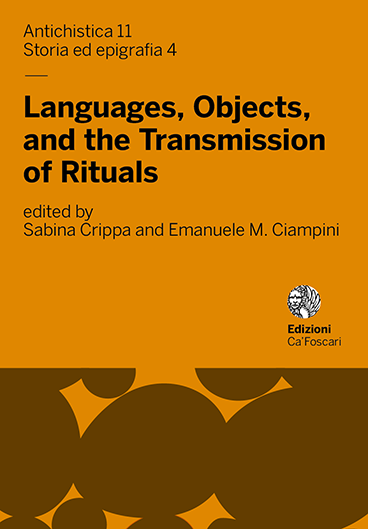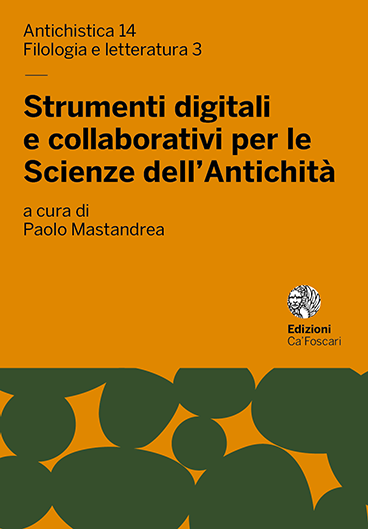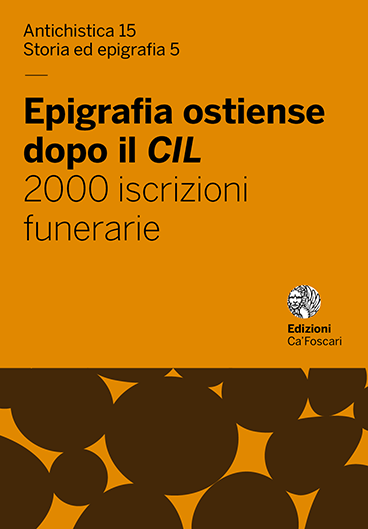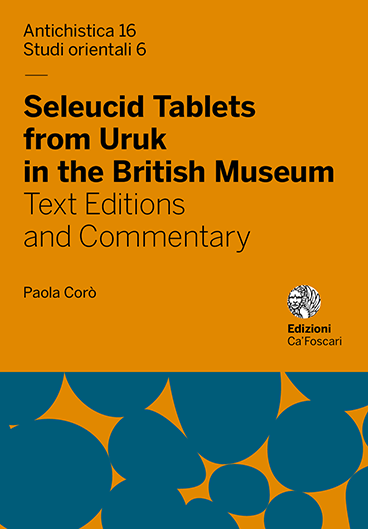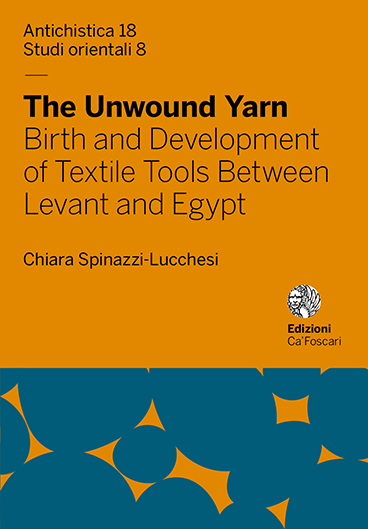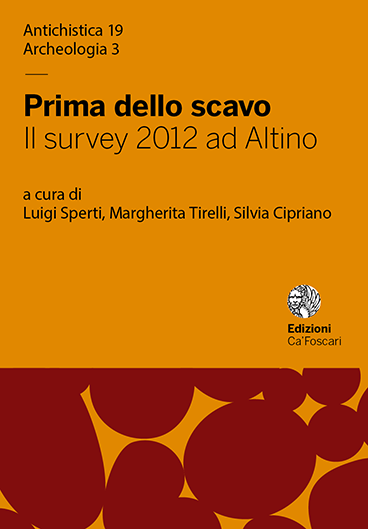[n.b. Newest volumes at the end of the list]
![]()
30 Mar 2013
Microstorie di romanizzazione
a cura di Giovannella Cresci Marrone, Patrizia Solinas
Il volume si incentra sull’edizione di 60 iscrizioni (di cui 6 in alfabeto cosiddetto leponzio e 54 in alfabeto latino ...
![]()
1 Apr 2013
Aspetti del sistema preposizionale dell’eblaita
Maria Vittoria Tonietti
La possibilità di penetrare il significato di un testo dipende ampiamente da una corretta comprensione del valore semantico delle preposizioni impiegate ...
![]()
1 Ott 2013
Festòs protopalaziale
Ilaria Caloi
Lo scopo di questo lavoro è la pubblicazione di due strutture del periodo Protopalaziale (XX-XVIII sec. a.C.) situate nel quartiere ...
![]()
25 Nov 2014
Poteri e legittimità nel mondo antico
a cura di Stefania De Vido
La storia della politica nel mondo antico ha costituito uno degli interessi centrali di Pierre Carlier, scomparso nel 2011. Allo studioso ...
![]()
10 Dic 2014
Storia e storie della lingua greca
a cura di Caterina Carpinato
Questo volume si occupa di storia della lingua greca, partendo dal presupposto che essa vada studiata in una prospettiva autenticamente diacronica ...
![]()
13 Gen 2015
Antichità egizie e Italia
a cura di Emanuele Marcello Ciampini, Paola Zanovello
Il volume raccoglie i contributi presentati nel corso di un convegno sul tema delle antichità egizie e, più in generale, su ...
![]()
20 Feb 2015
La lupa sul Nilo
a cura di Emanuele Marcello Ciampini, Francesca Rohr Vio
La vicenda di Gaio Cornelio Gallo matura sullo sfondo della profonda trasformazione che caratterizzò il I secolo a.C. Intellettuale di ...
![]()
30 Dic 2015
Commensality and Ceremonial Meals in the Neo-Assyrian Period
Stefania Ermidoro
Like a language, food is a witness to the tradition and to the identity of a human group, reflecting self-representation and ...
![]()
8 Lug 2016
The Reception of Sumerian Literature in the Western Periphery
Maurizio Viano
This book investigates the transmission of Sumerian literature to Syria and Anatolia (i.e. the Western periphery) during the Late Bronze ...
![]()
1 Mar 2017
L’edificio protopalaziale dell’Acropoli Mediana di Festòs (Vani CV-CVII)
Giorgia Baldacci
The present book consists in the full publication of both the structures and related finds excavated in the Protopalatial building located ...
![]()
12 Lug 2017
Languages, Objects, and the Transmission of Rituals
a cura di Sabina Crippa, Emanuele Marcello Ciampini
The transformations in ancient mind can be recognized by means of texts, which testify to the elaboration of the cultural semantic ...
![]()
13 Giu 2017
The City of Ebla
Erica Scarpa
This book lists more than 2,600 bibliographical entries referring to books, articles, and digital resources concerned with the ancient city ...
![]()
1 Set 2017
Certissima signa
a cura di Filippomaria Pontani
The observation of the stars has never just been a matter of ‘science’, but has constantly interacted with other domains, such ...
![]()
29 Nov 2017
Strumenti digitali e collaborativi per le Scienze dell’Antichità
a cura di Paolo Mastandrea
Il libro costituisce l’esito di un Convegno internazionale di studi tenutosi all’Università Ca’ Foscari nel 2014, e si propone ...
![]()
7 Mag 2018
Epigrafia ostiense dopo il CIL
a cura di Maria Letizia Caldelli, Mireille Cébeillac-Gervasoni, Nicolas Laubry, Ilaria Manzini, Raffaella Marchesini, Filippo Marini Recchia, Fausto Zevi
Ostia è, dopo Roma, la città dell’Impero che ha restituito il maggior numero di iscrizioni latine. Dopo la pubblicazione del ...
![]()
5 Apr 2018
Seleucid Tablets from Uruk in the British Museum
Paola Corò
Between the second half of the 19th century and the first half of the 20th century the British Museum acquired as ...
![]()
18 Mag 2018
Personal Names in the Aramaic Inscriptions of Hatra
Enrico Marcato
This book offers a comprehensive linguistic evaluation of the 376 personal names attested in the roughly 600 Aramaic inscriptions of Hatra ...
![]()
4 Lug 2018
The Unwound Yarn
Chiara Spinazzi-Lucchesi
This book reviews certain of the most important archaeological finds of textile tools, in order to draw a picture of the ...
![]()
20 Nov 2018
Prima dello scavo
a cura di Luigi Sperti, Margherita Tirelli, Silvia Cipriano
Il volume raccoglie i risultati della prima campagna della ricognizione archeologica effettuata dall’Università Ca’ Foscari nel sito di Altino, in ...


 to open them.
to open them.














































